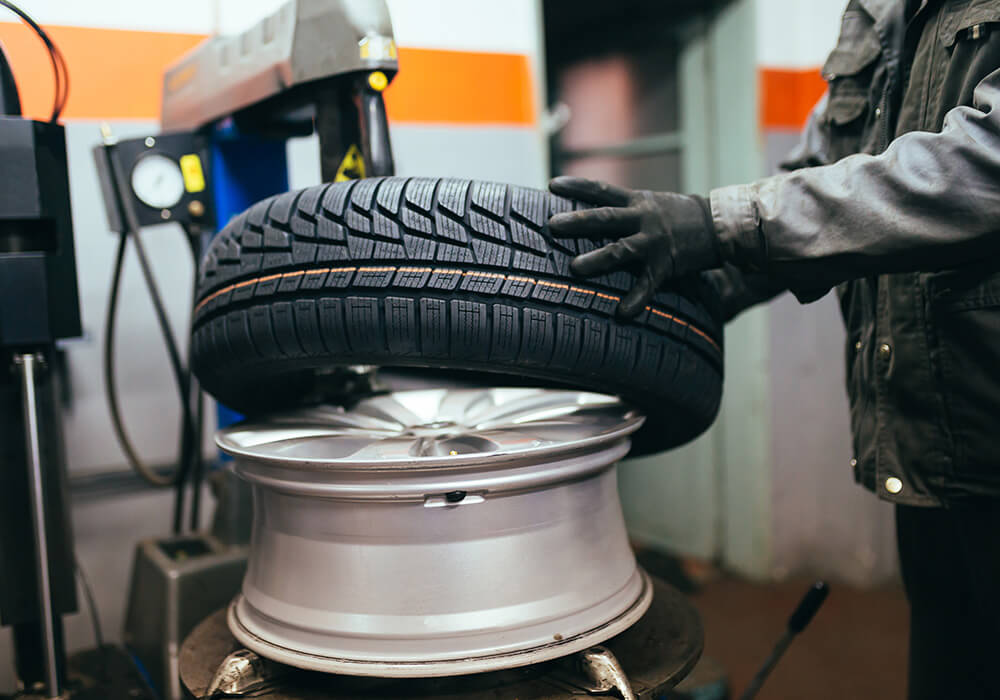Tire Solution: The Impact of Climate Problems
When it comes to ensuring optimal efficiency and safety on the road, comprehending the influence of weather condition problems on tire solution is essential. GMC Tire Service. In this conversation, we will check out the complex partnership in between weather conditions and tire solution, losing light on the importance of weather-specific tire maintenance practices and factors to consider.
Heat and Tire Efficiency
When revealed to high temperatures, tires experience changes in efficiency that can significantly affect car safety and handling. The warmth produced from long term driving or warm climate conditions creates the tire rubber to soften, leading to minimized tread life and boosted wear.

Cold Weather Impacts
Winter problems can have a significant impact on tire performance and security. As temperature levels decrease, tire rubber can solidify, resulting in reduced grip on icy or snow-covered roadways. In chilly climate, tires may also lose air pressure much more quickly, which can affect handling and gas efficiency. Furthermore, cool temperatures can create tire sidewalls to tense, raising the threat of damage from pits or various other road threats.
To minimize the effects of cool weather on tires, it is important to frequently inspect tire pressure and inflate them to the producer's advised degrees. Utilizing winter months or all-season tires created for winter problems can additionally enhance traction and hold on icy or snowy roadways. Proper tire maintenance, including normal inspections for wear and damage, becomes a lot more crucial throughout chillier months to make certain optimal efficiency and safety and security.
Rainy Issues Effect
Tires with worn-out footsteps are more vulnerable to hydroplaning, where a layer of water constructs up in between the tire and the road surface, leading to loss of grip. To battle this, drivers must consistently check their tires for sufficient tread deepness and consider investing in tires especially developed for damp conditions.
In addition, rainy weather can likewise reduce exposure, making it testing for drivers to see the road ahead clearly (GMC Tire Service). In such problems, it is vital to adjust driving speeds as necessary and keep a risk-free adhering to distance to enable sudden stops. Properly filled with air tires can likewise assist in maintaining control on wet roads by giving better handling and grasp
Snow and Tire Security
When driving in snowy problems, having go the right tires can make a significant difference in security and performance. Wintertime tires are made with special rubber substances and tread patterns to supply far better traction on snow and ice contrasted to all-season tires.

Moreover, motorists must think about installing tire chains in severe snowy conditions. Tire chains supply added grip by gripping the snow and ice, boosting security and control. However, it is necessary to adhere to producer guidelines when using and installing tire chains to stop damages to the tires and car. By selecting the ideal tires, maintaining proper rising cost of living, and considering additional traction help like tire chains, vehicle drivers can boost their security when navigating snow-covered roads.
Weather-Related Tire Maintenance
When confronted with different weather, appropriate tire upkeep ends up being a crucial facet of automobile safety and security and performance. Weather-related tire maintenance includes a variety of techniques focused on making sure optimum tire feature and durability in different climate situations. One vital aspect of weather-related tire maintenance is tire pressure regulation. Rising and fall temperatures can cause tire pressure to vary, affecting grip and fuel performance. Consistently examining and adjusting tire stress according to producer suggestions is necessary for risk-free driving in altering climate condition. Additionally, tire tread deepness plays a substantial role in managing various weather condition elements. Tires with adequate tread deepness provide much better hold on wet or icy roads, minimizing the risk of hydroplaning or skidding. Checking tire step on a regular basis and replacing tires when tread wear gets he said to a particular deepness is vital for preserving grip and stability in damaging weather condition. By prioritizing weather-related tire maintenance, motorists can boost safety and security, improve car efficiency, and prolong the life expectancy of their tires.
Conclusion
In conclusion, climate conditions have a considerable impact on tire efficiency and safety and security. From warmth impacting tire pressure and put on to cold weather lowering traction, it is crucial to consider the weather when keeping and making use of tires.
In this conversation, we will check out the complex relationship in between weather problems and tire solution, losing light on the significance of weather-specific tire upkeep methods and factors to consider.
